
The Seagram Building is a skyscraper at 375 Park Avenue, between 52nd and 53rd Streets, in the Midtown Manhattan neighborhood of New York City. Designed by Ludwig Mies van der Rohe along with Philip Johnson, Ely Jacques Kahn, and Robert Allan Jacobs, the high-rise tower is 515 feet (157 m) tall with 38 stories. The International Style building, completed in 1958, initially served as the headquarters of the Seagram Company, a Canadian distiller.

The MetLife Building is a skyscraper at Park Avenue and 45th Street, north of Grand Central Terminal, in the Midtown Manhattan neighborhood of New York City. Designed in the International style by Richard Roth, Walter Gropius, and Pietro Belluschi and completed in 1962, the MetLife Building is 808 feet (246 m) tall with 59 stories. It was advertised as the world's largest commercial office space by square footage at its opening, with 2.4 million square feet (220,000 m2) of usable office space. As of November 2022, the MetLife Building remains one of the 100 tallest buildings in the United States.
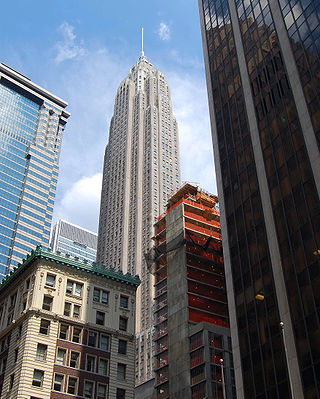
70 Pine Street is a 67-story, 952-foot (290 m) residential building in the Financial District of Lower Manhattan in New York City. Built from 1930 to 1932 by energy conglomerate Cities Service Company, the building was designed by the firm of Clinton & Russell, Holton & George in the Art Deco style. It was Lower Manhattan's tallest building and the world's third-tallest building upon its completion.

40 Wall Street is a 927-foot-tall (283 m) neo-Gothic skyscraper on Wall Street between Nassau and William streets in the Financial District of Manhattan in New York City. Erected in 1929–1930 as the headquarters of the Manhattan Company, the building was designed by H. Craig Severance with Yasuo Matsui and Shreve & Lamb. The building is a New York City designated landmark and is listed on the National Register of Historic Places (NRHP); it is also a contributing property to the Wall Street Historic District, an NRHP district.
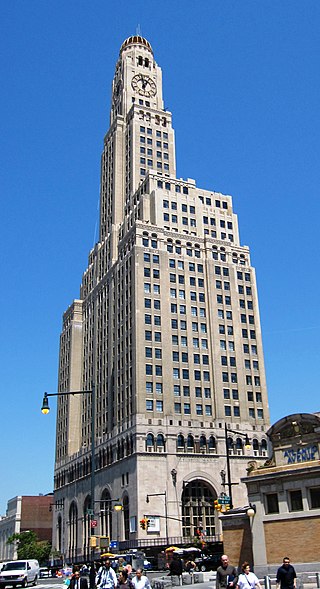
The Williamsburgh Savings Bank Tower, also known as One Hanson Place, is a skyscraper in the Fort Greene neighborhood of Brooklyn in New York City. Located at the northeast corner of Ashland Place and Hanson Place near Downtown Brooklyn, the tower was designed by Halsey, McCormack and Helmer and constructed from 1927 to 1929 as the new headquarters for the Williamsburgh Savings Bank. From the time of its construction until 2009, the Williamsburgh Savings Bank Tower was the tallest building in Brooklyn at 41 stories and 512 feet (156 m) tall.
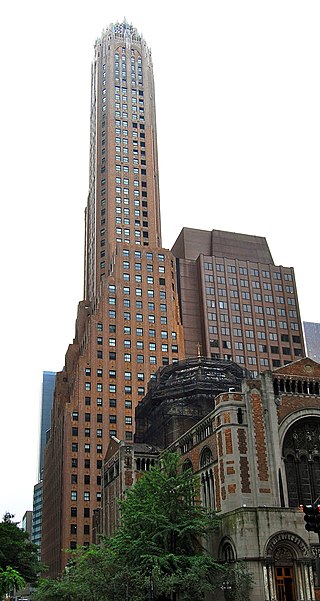
The General Electric Building, also known as 570 Lexington Avenue, is a skyscraper at the southwestern corner of Lexington Avenue and 51st Street in Midtown Manhattan, New York City. The building, designed by Cross & Cross and completed in 1931, was known as the RCA Victor Building during its construction. The General Electric Building is sometimes known by its address to avoid confusion with 30 Rockefeller Plaza, which was once known as the GE Building.

The David N. Dinkins Municipal Building is a 40-story, 580-foot (180 m) building at 1 Centre Street, east of Chambers Street, in the Civic Center neighborhood of Manhattan in New York City. The structure was built to accommodate increased governmental space demands after the 1898 consolidation of the city's five boroughs. Construction began in 1909 and continued through 1914 at a total cost of $12 million.

The New Yorker Hotel is a mixed-use hotel building at 481 Eighth Avenue in the Hell's Kitchen neighborhood of Manhattan in New York City. Opened in 1930, the New Yorker Hotel was designed by Sugarman and Berger in the Art Deco style and is 42 stories high, with four basement stories. The hotel building is owned by the Unification Church, which rents out the lower stories as offices and dormitories. The upper stories comprise The New Yorker, A Wyndham Hotel, which has 1,083 guestrooms and is operated by Wyndham Hotels & Resorts. The 1-million-square-foot (93,000-square-meter) building also contains two restaurants and approximately 33,000 square feet (3,100 m2) of conference space.

The Jackson Heights–Roosevelt Avenue/74th Street station is a New York City Subway station complex served by the IRT Flushing Line and the IND Queens Boulevard Line. Located at the triangle of 74th Street, Broadway, and Roosevelt Avenue in Jackson Heights, Queens, it is served by the 7, E, and F trains at all times; the R train at all times except late nights; and the <F> train during rush hours in the reverse peak direction.

The Roosevelt Hotel is a former hotel at 45 East 45th Street in the Midtown Manhattan neighborhood of New York City. Named in honor of U.S. president Theodore Roosevelt, the hotel was developed by the New York Central Railroad and the New York, New Haven and Hartford Railroad and opened in 1924. The 19-story structure was designed by George B. Post & Son with an Italian Renaissance Revival-style facade, as well as interiors that resembled historical American buildings. The Roosevelt Hotel is one of several large hotels developed around Grand Central Terminal as part of Terminal City.

330 West 42nd Street, also the McGraw-Hill Building and formerly the GHI Building, is a skyscraper in the Hell's Kitchen neighborhood of Manhattan in New York City. Designed by Raymond Hood and J. André Fouilhoux in a mixture of the International Style, Art Deco, and Art Moderne styles, the building was constructed from 1930 to 1931 and originally served as the headquarters of McGraw-Hill Companies. The 485-foot-tall (148 m) building contains 33 stories.

The InterContinental New York Barclay Hotel is a hotel at 111 East 48th Street, on Lexington Avenue between 48th and 49th Streets, in the Midtown Manhattan neighborhood of New York City. The 14-story hotel, operated by IHG Hotels & Resorts, was designed by Cross and Cross in the Colonial style and contains 702 rooms. The Barclay was one of several large hotels developed around Grand Central Terminal as part of Terminal City.
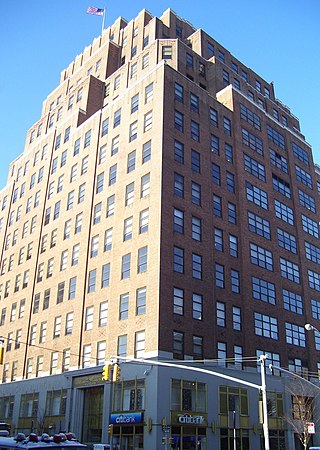
111 Eighth Avenue, also known as the Google Building and formerly known as Union Inland Terminal #1 and the Port Authority Building, is an Art Deco multi-use building in the Chelsea neighborhood of Manhattan, New York City. Fifteen stories tall and occupying an entire city block, it has 2.9 million square feet (270,000 m2) of floor space, more than the Empire State Building.

Row NYC Hotel is a hotel at 700 Eighth Avenue, between 44th and 45th Streets, in the Midtown Manhattan neighborhood of New York City. The hotel is 27 stories tall with 1,331 rooms. Designed by Schwartz & Gross, with Herbert J. Krapp as consulting architect, it was developed by brothers Henry and Irwin Chanin and opened on February 1, 1928, as the Hotel Lincoln. The hotel largely retains its original brick-and-terracotta facade. The interior spaces, which originally included a lobby and various restaurants on the first three stories, have been redesigned substantially over the years.

The Peninsula New York is a historic luxury hotel at the corner of Fifth Avenue and 55th Street in the Midtown Manhattan neighborhood of New York City. Built in 1905 as the Gotham Hotel, the structure was designed by Hiss and Weekes in the neoclassical style. The hotel is part of the Peninsula Hotels group, which is owned by Hongkong and Shanghai Hotels (HSH). The structure is 23 stories high and, as of 2022, contains 241 rooms.

The International Building, also known by its addresses 630 Fifth Avenue and 45 Rockefeller Plaza, is a skyscraper at Rockefeller Center in the Midtown Manhattan neighborhood of New York City. Completed in 1935, the 41-story, 512 ft (156 m) building was designed in the Art Deco style by Raymond Hood, Rockefeller Center's lead architect. The main tower is set back from Fifth Avenue and includes two 6-story wings to the east, known as Palazzo d'Italia and International Building North. The wings flank an entrance plaza that contains Lee Lawrie's Atlas statue.

608 Fifth Avenue, also known as the Goelet Building or Swiss Center Building, is an office building at Fifth Avenue and West 49th Street in the Midtown Manhattan neighborhood of New York City, adjacent to Rockefeller Center. It was designed by Victor L. S. Hafner for the Goelet family, with Edward Hall Faile as structural engineer. The facade uses elements from both the Art Deco and International styles, while the lobby was designed exclusively in the Art Deco style.
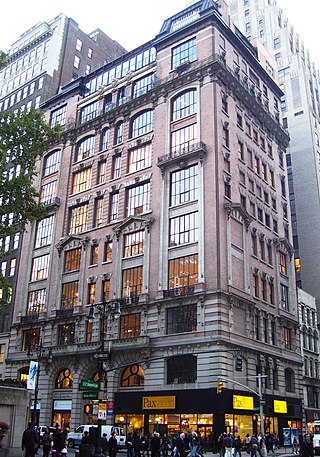
The Bryant Park Studios is an office building at 80 West 40th Street in the Midtown Manhattan neighborhood of New York City, at the corner of 40th Street and Sixth Avenue. The building, overlooking the southwest corner of Bryant Park, was designed by Charles A. Rich in the French Beaux-Arts style. Built from 1900 to 1901 by Abraham A. Anderson, the building is one of several in Manhattan that were built in the early 20th century as both studios and residences for artists.

200 Madison Avenue is a 25-story office building in the Murray Hill neighborhood of Manhattan in New York City. It is along the west side of Madison Avenue between 35th and 36th Streets. Designed by Warren and Wetmore, it was built from 1925 to 1926.

The Sofia is a condominium building at the corner of Columbus Avenue and 61st Street on the Upper West Side of Manhattan in New York City. It was constructed from 1929 to 1930 and was designed by the firm of Jardine, Hill & Murdock in the Art Deco style for Kent Automatic Garages. The Sofia is 27 stories tall; the first nine stories above the ground level are used as offices, while the top 17 stories contain residential condominiums. The building is a New York City designated landmark and on the National Register of Historic Places.

























